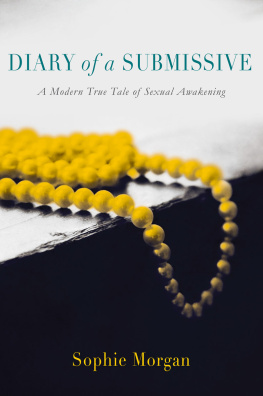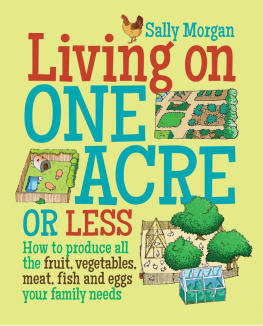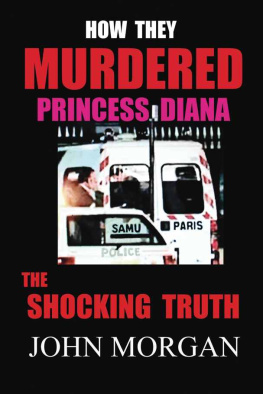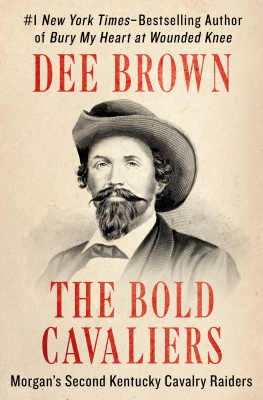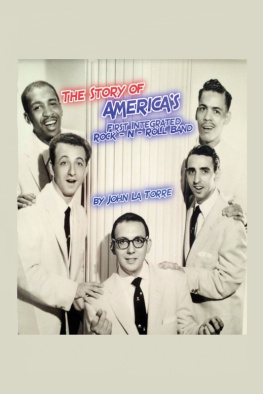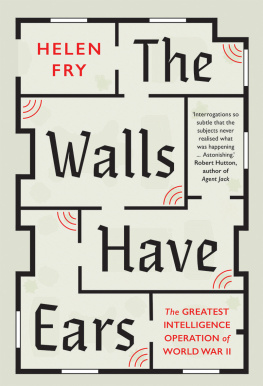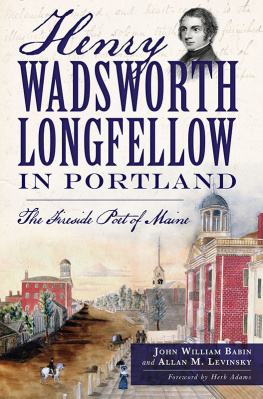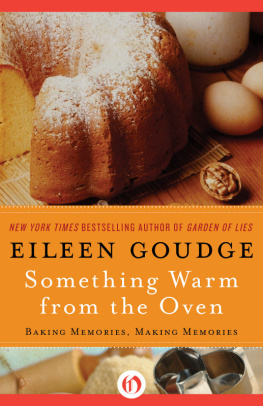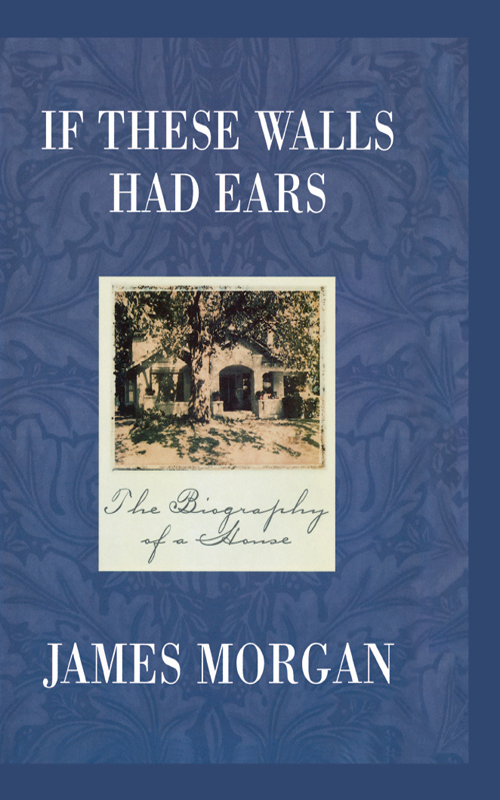Copyright 1996 by James Morgan
All rights reserved.
Warner Books, Inc.,
Hachette Book Group
237 Park Avenue
New York, NY 10017
Visit our website at www.HachetteBookGroup.com
First eBook Edition: September 2009
ISBN: 978-0-446-56509-7
Photo credits: The author wishes to thank the following for the use of their photographs. If not listed below, the photographs are from the authors own collection. Jack Burney.
For Beth
The history of a nation is not in parliaments and battlefields, but in what the people ay to each other on fair days and high days, and in how they farm, and quarrel, and go on pilgrimage.
WILLIAM BUTLER YEATS
I n the middle of the night, a house creaks under the weight of its secrets. This isnt merely the racing imagination of someone startled awake by strange noises; this is a middle-aged mans bone-deep knowledge of the way life bears on living things.
A house is a body, like yours and mine. Its not such a stretch to think of beams as bones, electrical wiring as a nervous system, plaster and brick as the layers of skin that protect us from the elements. And yet uninhabited houses and uninhabited bodies are only compelling to contractors and coroners. It takes a soul to give a body life.
Ive always been curious about the houses Ive lived in, wondered who lived there before me and what their stories were like. But I never looked into any of their histories. There was always todays business to attend to. Besides, as with so many of us in the last half of the twentieth century, Ive lived in too many housestwenty-five, to be exact, counting student apartments and starter town houses, from the time I was born up through today. Until I moved into the house Im now in, and in which Ive lived almost seven years, the longest I had lived in any one place was four years and eight months. That was the house my family moved to in Miami, Florida, where I lived from the middle of eighth grade until I left for college. They stayed there twenty years, but I never really went home again. In fact, Im not sure Ive been there at all.
The story of America has always been the story of a search for home. Its a restless journey in which we never quite seem to arrive. In my case, five times Ive followed jobs toward a goal I thought would make me complete. Probably not coincidentally, Ive moved twice from would-be homes exposed by failed marriages, setting out alone again to create in life that ideal home that exists only inside my head. Though home is a spiritual concept, it tends to take on physical weight. For the longest time, I couldnt actually describe the place that pressed so upon me; I would just inch my way toward what felt right.
But somewhere along the journey, a picture began to develop in my consciousness. The house is larger inside than it looks from the street. It has fourteen-foot ceilings and gracefully spacious rooms. Its furnishings are old and elegant and a little bit worn. There are solid tables piled high with books and peopled with photos of loved ones in silver frames; in the hall, still other family photographs cover one wall from floor to ceiling. A hardwood log crackles in the fireplace. In the dining room, a massive table is set for twelve. Theres a screened back porch lined with rockers, and a laughing crowd of siblings and cousins flows constantly between that porch and the kitchen, where the family is anchored by a sturdy round oak table set dead in the center. Sometimes, in my daydreams, Im among that group and sometimes Im not. Sometimes Im hidden away in one of the nooks and crannies in this house thats large enough to provide such places to get lost in, and Im reading a book in an easy chair, with the afternoon sun streaming in through the ceiling-high windows, filtered by the sheers.
Is anyone surprised that Ralph Lauren is a rich man?
But this isnt some ideal Ive absorbed from reading magazines. The house is actually my aunt Mays house in Hazlehurst, Mississippi. What does it say about me that this is the first house I ever lived in, when my father was away at war and my mother took me home to her sisters?
As a home, that house turned out far from ideal for those who grew up in it day by day. But for me, thats beside the point. For me, the distance works. The distance spins magic, allowing me to create in my own head the illusion of a life thats comfortable and carefree and safe. Thats a childish notion, I know, but who believes that grown-ups are anything but vulnerable children at heart? Besides, thats one of the things that the home we all chase isa place, a condition, in which the world cant touch you.
My aunts house also probed this raw nerve of permanence with me. By the time she died in the spring of 1993, she had lived in that house just shy of seventy years. She knew every square inch of wall, every layer of paint, every scuff on the baseboard, every worn spot on the carpet. In the middle of the night, when she was awakened by creaks, she heard the squeals of her children and the laughter of her friends arid, yes, the anguished howls of her own private demons. But at least they were her demons.
The house I live in now with my wife and stepdaughters fulfills some of the requirements of the house in my head. Its a bungalow in the Craftsman style, which means its low-slung and solid. It hugs a hill. And yet the house isnt simple and forthcoming in the usual Craftsman waythere are curlicues under the eaves, and arches that seem to curve slightly skyward, evoking an air of mystery thats almost Oriental. It also has a second story. At 3,200 square feet, with five bedrooms, a studio, and an office, its larger than it looks from the outside, and many of our furnishings are old and elegant arid worn. We have stacks of books and an open-air front porch lined with rockers. But our dining table wont comfortably seat twelve, and we somehow never get all our snapshots framed (or even developed). The ceilings are only ten feet high and the rooms, while generous, arent as big as the rooms in my mind. There is no sturdy round anchor in the kitchen. The house is complex enough to provide hiding places, if, as at my aunts house in recent years, there were only one person living in it. But with four of us and a dog here, we can run but we cant very well hideat least not long enough to enjoy an uninterrupted book bathed in the warmth of the afternoon sun.
In the upstairs hall, weve covered a wall with family photographs, but its the all-too-new kind of American family photo gallery: spliced history. The center of this grouping is a montage from Beths and my wedding just over six years ago. Here we are kissing, as her little girls, Blair and Bret, and my lanky boys, David and Matthew, look ona little glumly, it seems to me. Over here to the left theres a snapshot of the new nuclear family, and, down here, a portrait of the new extended family as wellfour generations of Arnolds and three of Morgans, posed on a wide staircase, a hybrid genealogical tree forced by modern life to put down new roots, and to tie off old ones. Some of the people in this picture have just met.
No wonder so many people gravitate to old houses, with their comforting implications about the test of time.
In the summer of 1992, on a night when Beth was out of town and the girls were with their dad, I had supper with our neighbors. One of the couples had lived in their house six years, the other thirteen. They were telling stories about the neighborhood, one of which concerned my house. It seems that during one period back in what the neighbors thought was the 1970s, this house was briefly turned into apartments.


